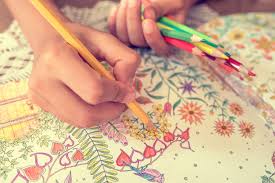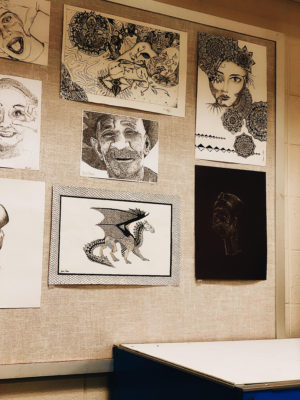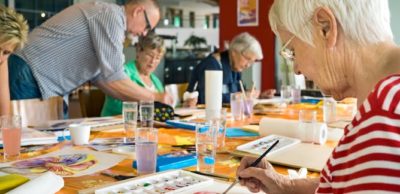
SEARCY, AR. (LP) — Art no matter whether you choose to create it yourself or simply observe and enjoy it – is a relaxing and inspiring activity for many people. However, the particular benefits of artistic expression go much further than relaxation and enjoyment. Studies suggest that art therapy can be very valuable in treating issues such as depression, anxiety, post-traumatic stress disorder and even some phobias. It is a great way to express your emotions without words, process complex feelings and find relief. In this article, we will take a closer look at art therapy and discuss its mental health benefits. A teacher from Searcy High School, Terry Hester states, “Even though I’m not in the medical field, yes, I believe it is healing. It’s a way to distress.” Art therapy can be defined in many ways, but the simplest way to define it is an application of the visual arts in a therapeutic context. You don’t necessarily have to see a therapist in order to experience some of the therapeutic benefits of artistic expression. There are many simple activities you can try from the comfort of your home such as art journaling, sketching, making collages, sculpting with clay, etc. It doesn’t matter what media you choose.

The only thing that matters is that you feel comfortable using it. However, working with a licensed therapist also has its advantages because a professional can tailor each activity to your own needs. If the activities are done in a group, they are excellent for building healthy connections with other people, which may be very helpful if you are fighting depression. The most important thing is that you should try art therapy only if you want it. Expressing yourself through art can be self-revealing and sometimes equally painful as talking. So, if you still don’t feel ready to try it, that is okay. Anyone who feels overwhelmed or pressured by the hectic world we live in should try art therapy. Creating art will give you a chance to slow down and explore any issues you may be having. Art therapy improves the mental health of people who are dealing with addictions, anxiety, attention disorders, grief and loss, dementia, depression, eating disorders, physical illness, PTSD, trauma, relationship issues and much more. Since the focus is on the process and not the final product, art therapy is not about becoming a great artist but about finding meaning and connection in your life. All you need for it is a willingness to experiment.
It is very important to know that you don’t have to be a talented artist in order to try art therapy. Human beings are innately creative, and all you need to do to complete an art therapy activity successfully is, to be honest with yourself and your emotions. Once you unleash your creativity, your inner artist will quickly wake up. Studies also show that creating art stimulates the release of dopamine. This chemical is released when we do something pleasurable, and it basically makes us feel happier. Increased levels of this feel-good neurotransmitter can be very helpful if you are battling anxiety or depression. Mental health professionals and experts agree that art therapy has many benefits, from boosting your self-esteem, and providing you a safe outlet to relieve your emotions, to giving you a sense of control over your life and helping you to get to know and understand yourself better. Zachary Duncan states, “I love art and always have, so I understand how Art Therapy could help soothe many people.” During the process of art creation, you will be taking yourself on a journey of self-discovery that will help you eliminate emotional roadblocks, and learn how to communicate with yourself and others. In psychology, the use of artistic methods to treat psychological disorders and enhance mental health is known as art therapy. Art therapy is a therapeutic technique rooted in the idea that creative expression can foster healing and mental well-being. Art, either the process of creating it or viewing others artworks, is used to help people explore their emotions, develop self-awareness, cope with stress, boost self-esteem, and work on social skills. Maria Smith a art student at Searcy High states, “I think it will help, just for the fact it’s a way to get away, it’s just an escape from everyday stuff.”

It may surprise you to learn that art can be an effective tool in mental health treatment. What could art possibly have to do with psychotherapy? As an expressive medium, art can be used to help clients communicate, overcome stress, and explore different aspects of their own personalities. Art therapy integrates psychotherapeutic techniques with the creative process to improve mental health and well-being. American Art Therapy Association describes art therapy as an approach to mental health that utilizes the process of creating art to improve mental, physical, and emotional wellness. The goal of art therapy is to utilize the creative process to help people explore self-expression and, in doing so, find new ways to gain personal insight and develop new coping skills. Techniques used in art therapy can include drawing, painting, coloring, sculpting, or collage. As clients create art, they may analyze what they have made and how it makes them feel. Through exploring their art, people can look for themes and conflicts that may be affecting their thoughts, emotions, and behaviors. People do not need to have artistic ability or special talent to participate in art therapy, and people of all ages including children, teens, and adults can benefit from it. Some research suggests that just the presence of art can play a part in boosting mental health. While people have been using the arts as a way to express, communicate, and heal for thousands of years, art therapy only began to formalize during the middle of the 20th-century. Doctors noted that individuals suffering from mental illness often expressed themselves in drawings and other artworks, which led many to explore the use of art as a healing strategy. Evan Owens Student at Searcy High School says, “I agree that art work created away from the art therapy environment can be a stress reliever but argue it’s not therapy, just art.”

Since then, art has become an important part of the therapeutic field and is used in some assessment and treatment techniques. An art therapist may use a variety of art methods including drawing, painting, sculpture, and collage with clients ranging from young children to the elderly. Clients who have experienced emotional trauma, physical violence, domestic abuse, anxiety, depression, and other psychological issues can benefit from expressing themselves creatively. Inpatient offices, private mental health offices, schools, and community organizations are all possible settings where art therapy services may be available. People often wonder how an art therapy session differs from the average art class. Where an art class is focused on teaching technique or creating a specific finished product, art therapy is more about letting clients focus on their inner experience. In creating art, people are able to focus on their own perceptions, imagination, and feelings. Clients are encouraged to create art that expresses their inner world more than making something that is an expression of the outer world. Art therapy can also help people with their social skills. The benefits of art therapy in these types of situations can help with people that are withdrawn or shy, or who, for some reason or another, have a difficult time functioning within social situations. Basically, the benefits of art therapy can be quite broad. It can improve lives by helping people improve their mental, emotional, and even physical states. It can raise the quality of life for many people, and it’s worth considering if it can aid you in some way or another.
